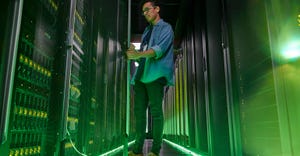
Insight and analysis on the data center space from industry thought leaders.
The Uneasy Discrepancy Between Innovation and Productivity
By using analytics and machine learning/AI, companies have irrefutable insights to help course correct how employees engage with any system, boost technology adoption, and ensure returns on the company’s technology investment.
September 20, 2017

Rephael Sweary is CEO and President of WalkMe.
We all expect that the latest technologies will help us work more effectively. But something isn’t adding up. Despite innovations in every industry, we can’t seem to be as efficient as we aspire to be.
Think about it: W’re working longer hours each year. We’re obsessed with squeezing every last minute from our day – from trying new ways to write our to-do list (or skipping it completely), or hacking into our sleep cycles. On a macro level, U.S. productivity growth continues to slump. Growth was negative in 2016, and declined 0.6 percent in Q1 – a continual sore spot for the economy. The question is, are the latest gadgets and applications inadvertently hindering our productivity?
C-level executives are constantly evaluating the latest tools in the quest to be more cost effective and productive. The problem is, we’re enamored by all the cool things that the technology can do, but not the ease and extent that people will use it.
The challenge is that while companies are investing more in new systems, we continue to provide a static, “one-size-fits-all” training in the workplace.
There are three problems with this approach. Firstly, such training ignores the fact that we possess different skills, experiences and aptitudes to learning. Secondly, training is usually conducted passively, rather than actively engaging with the system at the same time. Finally, research has shown that we’re likely to forget most of what we’ve learned within a day, rendering the training useless.
Uniform training practices mean that we don't know how many lost hours are spent in employees trying to comprehend and embrace a new system. When people don’t know the answer, they’ll likely ask their colleagues for help, or rely on search engines. At worst, they won’t use the technology at all, negating the company’s investment. With the pace of innovation only set to increase, this problem will only become more acute.
As such, there’s an urgency for business leaders to scrutinize their systems more carefully, and evaluate how straightforward it is to learn and adopt. While technologies should be intuitive, this can be more complex when flanked by other regulations and processes within a business.
The emergence of artificial intelligence (AI) and analytics – technologies that the likes of Google, Amazon, Apple and other tech titans are heavily investing in – are a clear pathway to addressing the uneasy dynamic between innovation and efficiency. At Google’s recent conference, the company talked extensively about transitioning from a “mobile-first” to a “AI-first” organization. It’s the realization that the ability to obtain hundreds of data points about the individual can then be applied to make more precise decisions about how we can improve how we work.
It’s human nature to make assumptions about other’s behaviors, but these aren’t always accurate. By using analytics and machine learning/AI, companies have irrefutable insights to help course correct how employees engage with any system, boost technology adoption, and ensure returns on the company’s technology investment.
Every business is awash in data these days, monitoring everything from customer satisfaction to helpdesk support. If we apply the same analysis internally to help people be more comfortable and proficient in how they work, they’ll be able to be more productive in getting the job done.
Most of us recognize that learning and development is at the core of what high performing companies do. A recent McKinsey survey of 1,500 global executives found that 60 percent of companies plan to increase learning and development spending, but about 40 percent of chief learning officers said that their initiatives were either “ineffective” or “neither effective nor ineffective” in assessing the capabilities and gaps of employees.
I believe that for training to be successful, it needs to be active and available for the individual. Existing investments don’t work as intended because they’re mired in fixed processes. Rather than scheduling passive training sessions, find ways where employees are empowered to learn when they need to and can access the tools in a more engaged fashion. Focus the training not just to the specific job functions, but to how to maximize the tools that they need to complete their work. And don’t be afraid to overturn age-old practices.
Introducing new training and technologies is a never-ending initiative in any organization. But with a deeper recognition of the challenges, further support for AI technologies and a greater depth of understanding at the individual level, the clear benefit will be greater efficiency long term.
Opinions expressed in the article above do not necessarily reflect the opinions of Data Center Knowledge and Informa.
Industry Perspectives is a content channel at Data Center Knowledge highlighting thought leadership in the data center arena. See our guidelines and submission process for information on participating. View previously published Industry Perspectives in our Knowledge Library.
About the Author
You May Also Like


.jpg?width=300&auto=webp&quality=80&disable=upscale)



.jpg?width=300&auto=webp&quality=80&disable=upscale)


